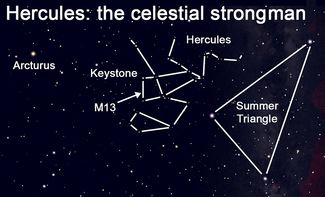Stargazers - The Celestial Strongman
Last updated 7/7/2016 at 5:08pm
No matter how long I study the sky there will always be star groupings I just can't see. The ancients certainly didn't make it easy for us. They never actually devised the constellations to look like animals, objects and people, but rather to simply represent them in the heavens.
That's why I'm indebted to author H. A. Rey who, in 1952, created an entirely new set of constellation figures based on those of the ancients for those of us who are pattern-challenged. Somehow, and I have no idea how, Rey was able to find stars within each constellation that are bright enough to see in suburban areas, and he connected them to form figures that actually resemble their constellations' namesakes.
For the past six and a half decades sky watchers have learned the constellations in this unique way. And today, whether they know it or not, most amateur astronomers see the heavens through the eyes of this creative genius. His classic book, "The Stars: A New Way to See Them," should be required reading for every stargazer on the planet.
While Rey's figures are quite easy to recognize in the book, we won't necessarily find them easily in the sky. It still requires patience and practice to spot them, and sometimes certain constellations still don't click for us.
For example, one of the star groupings that has always given me trouble is Hercules. Hercules is the fifth-largest constellation in the heavens, but because it doesn't contain any particularly brilliant stars it's not terribly prominent. Thankfully it does have four stars that trace a distorted square, or "keystone," and that is what I use to locate it. (And, being from the Keystone State of Pennsylvania you can imagine I'm rather fond of that shape.)
On July evenings look for the keystone nearly straight overhead, between the large Summer Triangle high in the east and the bright yellow-orange star Arcturus to the west. Hercules -- or Heracles, as the ancient Greeks knew him -- represents the immortal strongman who performed eight heroic deeds as well as the Twelve Labors of ancient Greek mythology.
In Rey's depiction the stellar keystone outlines the head of the strongman. The remaining stars in the constellation trace his body, but finding his appendages can be challenging for even the most imaginative stargazers.
If you find this and want another challenge, see if you can spot M13, aka the Great Globular Cluster in Hercules. On a clear, dark night M13 will appear to very good eyes as a smudge of light on the western side of the keystone. If you don't see it, try looking slightly off to the side of it for a better view. Binoculars show M13 easily. Even a small telescope will reveal its true nature: a globe of some 300,000 stars that lies some 21,000 light-years away from us -- nearly a quarter of the way across our Milky Way.
If you've never been able to identify constellations, maybe now's the time to pick up a copy of Rey's wonderful book and view them in a whole new way!




